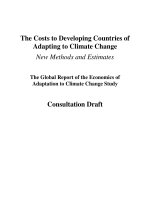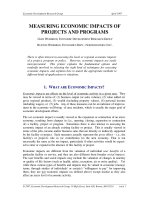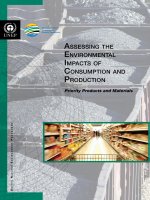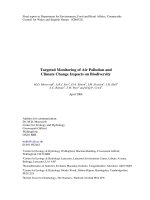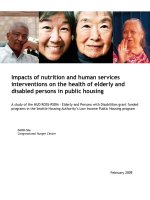Tiểu luận OVERVIEW: IMPACTS OF WEATHER AND CLIMATE EXTREMES WITHIN CLIMATE CHANGE – PRECIPITATION AND DROUGHT
Bạn đang xem bản rút gọn của tài liệu. Xem và tải ngay bản đầy đủ của tài liệu tại đây (318.27 KB, 6 trang )
Full name:
Nguyễn Thanh Tùng
Student code:10000820
Class:
K55TTKHMT
OVERVIEW: IMPACTS OF WEATHER AND CLIMATE EXTREMES
WITHIN CLIMATE CHANGE – PRECIPITATION AND DROUGHT
I.
Overview: Weather and climate extremes
Increase in average temperature leads to big changes in extreme weather
Impacts of Precipitation and Drought
Conclusion
OVERVIEW
T
he Earth’s climate has warmed by approximately 0.6 oC over past 100 years with two
main periods of warming, between 1910 and 1945 and from 1976 onwards. The rate
of warming has been nearly double that of the first and, thus, greater than at any
other time during 1000 years1
Changes in extreme weather and climate events have significant impacts and are
among the most serious challenges to society in coping with a changing climate 2.
Many extremes and their associated impacts are now changing. For example, there
are more unusually hot days and nights, fewer unusually cold days and nights, and
fewer frost days. Heavy downpours have become more frequent and intense.
Droughts are becoming more severe in some regions…
Recent weather events such as deadly heat waves and devastating floods have
sparked popular interest in understanding the role of global warming in driving
extreme weather. These events are part of a new pattern of more extreme weather
across the globe, shaped in part by human-induced climate change. As the climate
has warmed, some types of extreme weather have become more frequent and severe
in recent decades, with increases in extreme heat, intense precipitation, and drought.
In the future, with continued global warming, the phenomena of extreme weather
and climate events are very likely to further increase in frequency and intensity.
1|Page
II.
INCREASE IN AVERAGE TEMPERATURE LEADS TO BIG
CHANGE IN EXTREME WEATHER
All weather events are influenced by climate change because all weather now
develops in different environment than before.
European 2003 Summer Temperatures Were Far Outside Normal Range
2003 European Heat Wave: The Hottest Summer in 140 Years (1864-2003). Each vertical line
represents the average summer temperature for a single year from the average of four locations in
Switzerland over the period 1864 through 2003. This illustrates how far outside the normal range
the summer of 2003 was. Schär et al. 2004
Small changes in the averages of many key climate variables can correspond to
large changes in weather. Substantial changes in the frequency and intensity of
extreme events can result from a relatively small shift in the average of a
distribution of temperatures, precipitation, or other climate variables.
Climate Change Shifts the Odds for Extreme Weather Events
2|Page
Weather variation on our planet can be described with a rough bell-shaped curve.
Therefore so-called normal weather is very common while extreme weather is rare.
While events close to normal occur frequently, in the broad center of the curve,
there is a dramatic fall-off in the frequency of events further away from normal, in
the flatter ends of the curve.
III.
IMPACTS OF PREICIPITATION AND DROUGHT
Precipitation: “When it rains, it pours”.
Precipitation has increased in many regions of the world and decreased in others,
with little or no net change in total amount of precipitation. Generally, wet areas
have become wetter, and in contrast, dry areas have become drier in the past 40
years.
Over land, the precipitation record extends through-out the 20th century, and large
variations occur from year to year and on decadal time scales. Nonetheless, some
large-scale patterns of systematic change are evident (Trenberth et al. 2007a). In
general, there have been decreases in precipitation in the subtropics and tropics
outside of the monsoon trough, and increases in land precipitation at higher
latitudes, notably over North America, Eurasia, and Argentina. The decreases are
especially evident in the Mediterranean, southern Asia, and throughout Africa. In
the more northern regions, more precipitation falls as rain rather than snow (e.g.
Mote 2003, Knowles et al. 2006).
3|Page
Heavy precipitation: The water holding capacity of the atmosphere increases in a
warmer world. While an atmosphere that holds more moisture has greater potential
to produce heavier precipitation, precipitation events also become less frequent and
shorter, as it takes longer to recharge the atmosphere with moisture. In the wettest
areas of the tropical oceans, the most extreme rainfall events have increased by 60%
per degree of warming. The higher latitudes have become wetter in recent years, due
mainly to the warmer air holding more moisture and in part to alterations in
atmospheric circulation driven by climate change. At the same time, the subtropics
and parts of the tropics have become drier as winds carry the moisture away to the
monsoon rain areas or to mid-latitude storms.
Heavy rainfall can lead to numerous hazards, for example: flooding, landslides
including risk to human life, damage to buildings and infrastructure, and loss of
crops and livestock, disrupt transport and communications…
Drought: Threats to Water and Food Security
National Map: Drought Vulnerability
In the United States, parts of the Western U.S. are already experiencing water crises
because of severe dry-spells, but with climate change, the entire country will likely
face some level of drought. 1,100 counties - one-third of all counties in the lower 48
states - face higher risks of water shortages by mid-century as the result of climate
change. More than 400 of these counties will face extremely high risks of water
shortages.
4|Page
The increase in drought is caused by many factors: shortfalls in precipitation; earlier
snow melt; a shift away from light and moderate rains towards short, heavy
precipitation events; and increased evaporation from soil and vegetation due to
higher atmospheric temperatures, all of which have been driven at least in part by
climate change. Increased heating leads to greater evaporation of moisture from
land, thereby increasing the intensity and duration of drought. Individual droughts
have been linked to climate change, such as the drought that hit central India in
2008 when the north-south pattern of precipitation was disrupted by unusual
weather driven by abnormally high sea surface temperatures due in part to global
warming.5
As temperatures rise and precipitation decreases, water quality can be jeopardized.
Shrinking amounts of water can concentrate contaminants such as heavy metals,
industrial chemicals and pesticides, and sediments and salts. During drought,
drinking water supplies are susceptible to harmful algal blooms and other
microorganisms.
Of course, drought means more than not having access to clean drinking water.
Changes in precipitation and water availability could have serious consequences for
commercial agriculture – crops yield less and food security suffers. Drought
conditions can also help fuel out-of-control wildfires.
Water is life, and climate change is threatening this precious resource. Nearly every
U.S. region is facing some increased risk of seasonal drought. Climate change will
significantly affect the sustainability of water supplies in the coming decades. As
parts of the U.S get drier, the amount of water available and its quality will likely
decrease - impacting people's health and food supplies.
Drought of course threatens our water and food supplies and is driving up the cost
of everything from corn to milk. Unfortunately, drought conditions are expected to
become the new normal for many parts of many countries in the world if we don’t
do more to address climate change.
IV.
CONCLUSION
Our planet is facing many terrible phenomena that are results of climate change.
Human contributes to extreme weather and also tries to suffer its consequences.
Changes in extreme weather threaten human health as well as prosperity. Many
societies have taken measures to cope with historical weather extremes, but new,
more intense extremes have the potential to overwhelm existing human systems and
structures. More frequent and more severe extreme weather events are more likely
to destabilize ecosystems and cripple essential components of human livelihood,
such as food production, transportation infrastructure, and water management.
References:
5|Page
1. Climate Change 2001. Third Assessment Report of the Intergovernmental
2.
3.
4.
5.
6.
Panel on Climate Change IPCC. (WG I & II) (Cambridge Univ. Press,
Cambridge, 2001).
Weather and Climate Extremes in a Changing Climate (page VII) Synthesis
and Assessment Product 3.3 Report by the U.S. Climate Change Science
Program and the Subcommittee on Global Change Research EDITED BY:
Thomas R. Karl, Gerald A. Meehl, Christopher D. Miller, Susan J. Hassol,
Anne M. Waple, and William L. Murray
Changes in precipitation with climate change Kevin E. Trenberth - National
Center for Atmospheric Research, Box 3000, Boulder, Colorado 80307, USA
Climate Change and Water Supplies in the Wes Michael Dettinger, USGS
Rao, Suryachandra A., Hemantkumar S. Chaudhari, Samir Pokhrel, B. N.
Goswami, 2010: Unusual Central Indian Drought of Summer Monsoon
2008: Role of Southern Tropical Indian Ocean Warming. J. Climate, 23,
5163–5174. doi: 10.1175/2010JCLI3257.1
….
6|Page



